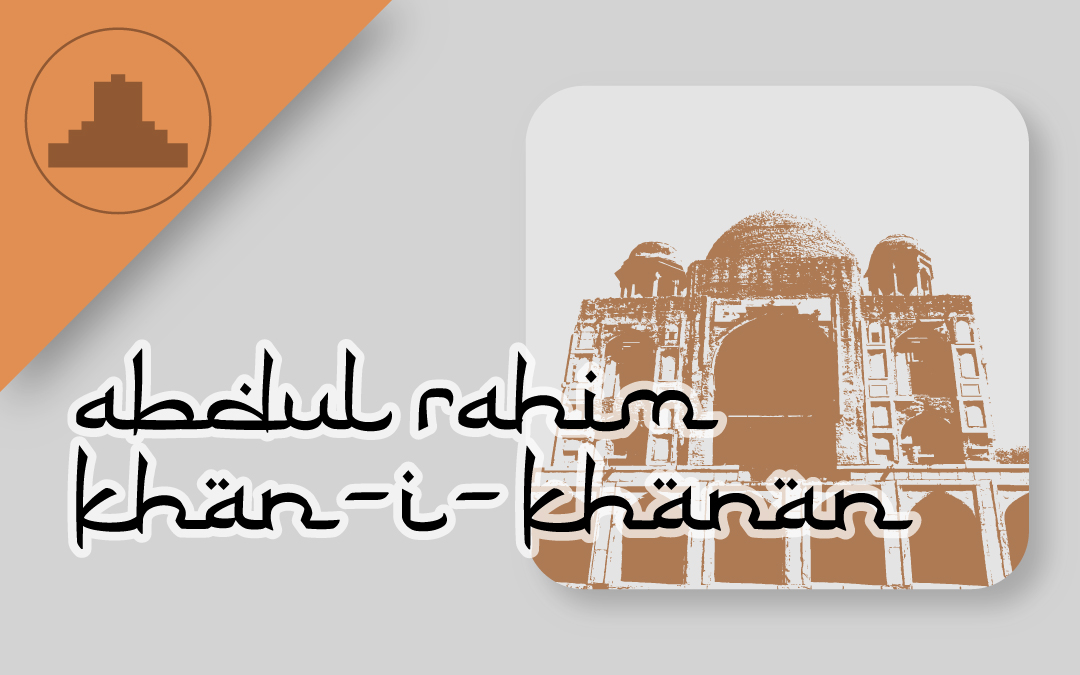रहिमन धागा प्रेम का, मत तोरो चटकाय. टूटे पे फिर ना जुरे, जुरे गाँठ परी जाय.
Narrative
The tomb was constructed in 1598 C.E. by Abdur Rahim for his wife Mah Banu. This was indeed the first Mughal tomb to be dedicated to a woman. Later, he was himself buried here, next to his wife, in 1627 C.E. The tomb is located on Delhi-Mathura road, one of the busiest roads in Delhi and therefore was ignored for several years and subjected to vandalism. The restoration work was initiated in 2104 with the combined efforts of Aga Khan Trust for Culture and Archaeological Survey of India.
Abdur Rahim Khan-i-Khanan was the son of Bairam Khan and one of the nine navratnas of Akbar’s court. He also served under Emperor Jahangir for almost 21 years. Apart from being a capable commander, he was a learned man and a poet. He wrote poetry in Arabic, Sanskrit and Turkish with great fluency along with composing dohas in Braj that became quite famous. He is also credited with translating Babur’s autobiography from Turkish to Persian. He was a patron of architecture as well and constructed an extensive water supply system in Burhanpur.
Architecture
The tomb was constructed in 1598 C.E. by Abdur Rahim for his wife Mah Banu. This was indeed the first Mughal tomb to be dedicated to a woman. Later, he was himself buried here, next to his wife, in 1627 C.E. The tomb rests on a chabutra which is 13feet 6inches high and has 17 arches on each side. There are two arches on northern and southern sides that lead to narrow underground rooms. The central chamber containing the grave of Abdur Rahim can be accessed by the central arch on the southern side. On either side of this entrance are staircases that lead to the top of the terrace. The mausoleum is constructed out of red sandstone and grey stone. Some influence of Humayun’s tomb can be seen in the tomb. On each side, the mausoleum has a central arched recess and consists of a small doorway that leads to the interior chamber. There are further smaller arched recesses on either side of the arched entrance on the upper and lower storeys. A huge dome tops the mausoleum with an octagonal chhatri on each corner. Interior of the mausoleum is adorned with incised and painted plaster work. There also exists a gallery of vaulted pavilions on the first storey that encircles the central tomb chamber. The roof has low vaulted dalans on all four sides at the back of the central arched recess. These dalans also appear at Humayun’s tomb. Another unusual feature of this tomb is that a flight of stairs on south-western side of the dome drum lead to the space between inner and outer dome. To access this space, there was an entrance containing a sliding stone door. The tomb is located on Delhi-Mathura road, one of the busiest roads in Delhi and therefore was ignored for several years and subjected to vandalism. In 2014, the restoration work began with the combined efforts of Aga Khan Trust for Culture and Archaeological Survey of India. They faced problem with removing a huge amount of concrete, cement and modern plaster, which were used during the earlier restoration. The team at work tried to keep the preservation, restoration and reconstruction work as close to the original work, using delhi quartzite and red sandstone. This technique is called ‘anastylosis’.
References
a. https://www.thehindu.com/society/history-and-culture/renovating-rahims-tomb-the-original-monument-of-love/article23279538.ece
b. “Monuments of Delhi: Lasting Splendour of the Great Mughals and Others. Volume II Delhi Zail.”1997.

